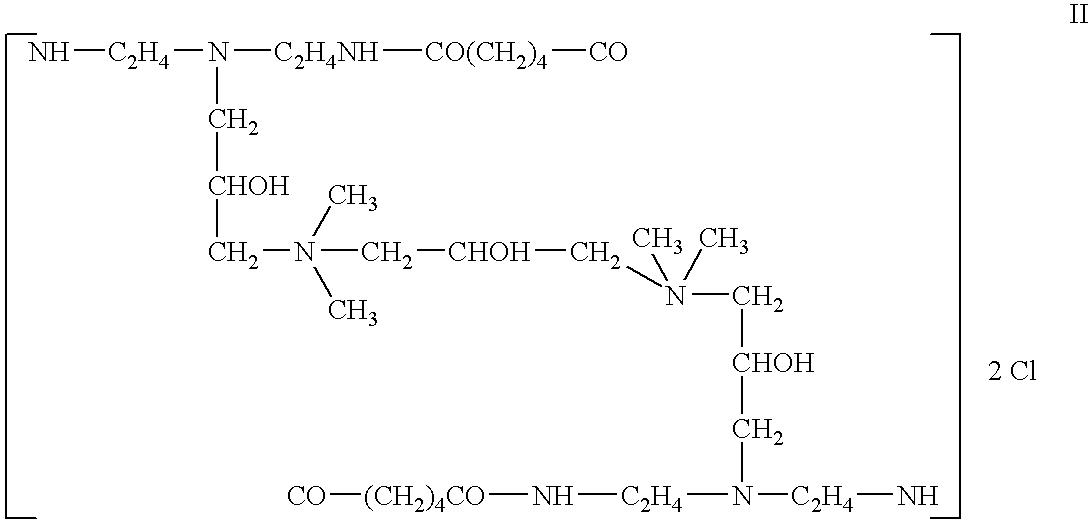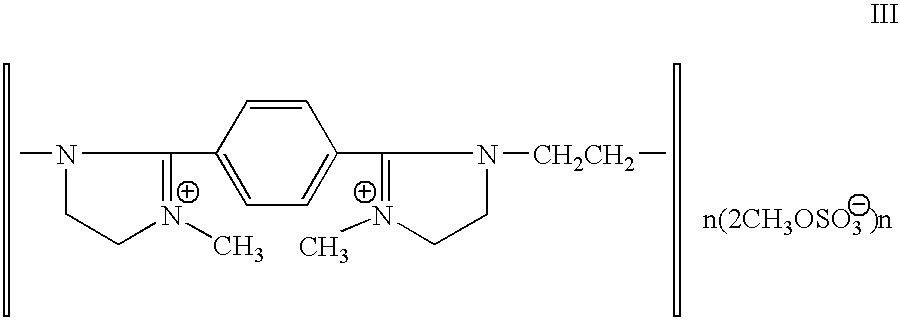Softening laundry detergent
a technology of laundry detergent and composition, applied in the field of laundry detergent composition, can solve the problems of many existing technologies still having disadvantages, and the garments feel harsh after washing
- Summary
- Abstract
- Description
- Claims
- Application Information
AI Technical Summary
Benefits of technology
Problems solved by technology
Method used
Image
Examples
example 1
[0152] This example demonstrates how good softening can be attained from formulations comprising a variety of different hydrophobic oils in conjunction with a cationic polymer and a surfactant base.
TABLE 3Formulation 1: Low-HLB Nonionic OilPercent in FormulaIngredient(based on 100% active)Alcohol Ethoxylate10.0Linear Alkylbenzene Sulfonic8.0AcidLauryl Ether Sufate3.0Ryoto L-59515.0Ucare Polymer LR-40020.3Ethanol 95%10.0Dowanol DPnP4.0Sodium Hydroxide2.46Triethanolamine1.0Sorbitol5.0Sodium Borate3.0Proteolytic Enzyme0.5Fluorescent Whitening Agent0.2Waterto 100
1Sucrose ester, HLB 5, available from Mitsubishi-Kagaku Foods Corporation, Tokyo.
2Available from Amerchol division of the Dow Chemical Company, Edison, N.J.
[0153]
TABLE 4Formulation 2: High HLB Nonionic OilPercent in FormulaIngredient(based on 100% active)Alcohol Ethoxylate10.0Linear Alkylbenzene Sulfonic8.0AcidLauryl Ether Sufate3.0Ryoto LWA-157015.0Ucare Polymer LR-40020.3Ethanol 95%10.0Dowanol DPnP4.0Sodium Hydroxide2.46Tr...
example 2
[0160] The following example demonstrates how formulations lacking anionic surfactant and those with high levels of cationic monomeric surfactant do not deliver the same softening benefit as the compositions of this invention. In addition, this example shows how modifying these parameters can yield unfavorable consumer parameters, such as high or low viscosities and phase separation.
TABLE 9Comparative Formulation 3: Comprises no Anionic SurfactantPercent in FormulaIngredient(based on 100% active)Alcohol Ethoxylate10.0Ryoto L-59515.0Ucare Polymer LR-40020.3Ethanol 95%10.0Dowanol DPnP4.0Triethanolamine1.0Sorbitol5.0Sodium Borate3.0Proteolytic Enzyme0.5Fluorescent Whitening Agent0.2Waterto 100
1Sucrose ester, HLB 5, available from Mitsubishi-Kagaku Foods Corporation, Tokyo.
2Available from Amerchol division of the Dow Chemical Company, Edison, N.J.
[0161]
TABLE 10Comparative Formulation 4: Comprises cationic monomeric surfactantPercent in FormulaIngredient(based on 100% active)Alcohol ...
example 3
[0167] This example demonstrates how the cleaning performance of the fabric conditioning compositions comprising cationic polymers, anionic surfactants and nonpolar oils can be improved by selecting an appropriate cationic polymer, pH, surfactant level and the presence of oil.
TABLE 14Formulation 4: Comprises Polymer of Optimal Molecular Weight,Hydrophobic Oil and more than 5% Surfactant at a pH of 8.5.Percent in FormulaIngredient(based on 100% active)Alcohol Ethoxylate10.0Linear Alkylbenzene Sulfonic8.0AcidLauryl Ether Sufate3.0Ryoto L-59515.0Ucare Polymer LR-40020.5Ethanol 95%10.0Dowanol DPnP4.0Sodium Hydroxide2.46Triethanolamine1.0Sorbitol5.0Sodium Borate3.0Proteolytic Enzyme0.5Fluorescent Whitening Agent0.2Waterto 100
1Sucrose ester, HLB 5, available from Mitsubishi-Kagaku Foods Corporation, Tokyo.
2Available from Amerchol division of the Dow Chemical Company, Edison, N.J.
[0168]
TABLE 15Comparative Formulation 6: Comprises Optimal Cationic Polymerand Surfactant Level, but Formul...
PUM
| Property | Measurement | Unit |
|---|---|---|
| weight average molecular weight | aaaaa | aaaaa |
| molecular weight | aaaaa | aaaaa |
| molecular weight | aaaaa | aaaaa |
Abstract
Description
Claims
Application Information
 Login to View More
Login to View More - R&D
- Intellectual Property
- Life Sciences
- Materials
- Tech Scout
- Unparalleled Data Quality
- Higher Quality Content
- 60% Fewer Hallucinations
Browse by: Latest US Patents, China's latest patents, Technical Efficacy Thesaurus, Application Domain, Technology Topic, Popular Technical Reports.
© 2025 PatSnap. All rights reserved.Legal|Privacy policy|Modern Slavery Act Transparency Statement|Sitemap|About US| Contact US: help@patsnap.com



